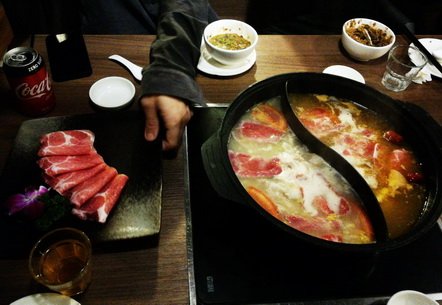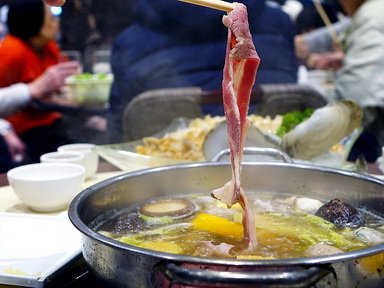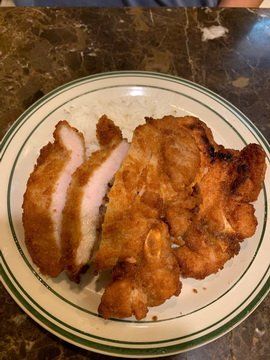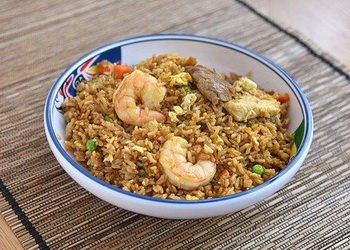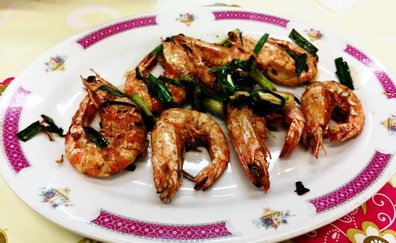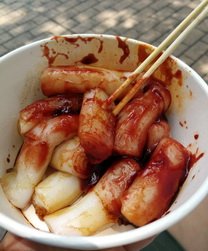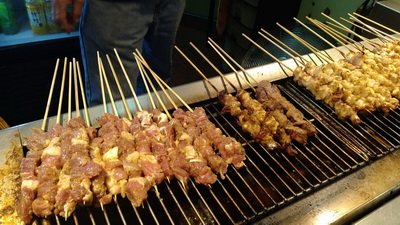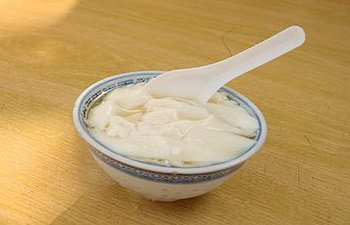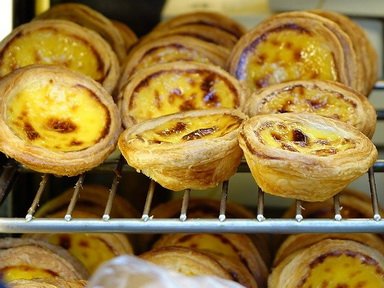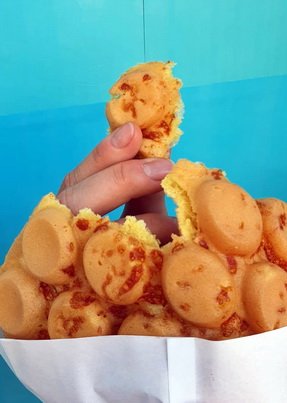To eat or not to eat… good question
What food should you try in Hong Kong, part 2
To eat or not to eat… what’s the answer?
Clay pot rice – Hot pot – Pork chop with rice – Fried rice – Sweet-sour pork – Seafood – Poon choi – Street food: rolled rice – Curry fish balls – Siu mai – Skewers – Potstickers – Bao/Pineapple bun – Stinky tofu – Sweets: Tofu pudding – Egg tart – Egg waffle – Medicinal tea – Mango pomelo sago dessert
Clay pot rice
That is as classic as it gets. It is so common, that the locals prefer more fancy food instead of this tasty, warm dish. It is traditionally eaten in winter and you will know why in a moment. What is more – it is the test of the skills of the chef – the crispiness of the rice should be golden and not burnt.
The name of the dish comes from the way it is prepared – in a clay pot. It is a tradition as old as civilization. It is said that the clay material allows the dish to breathe while cooking, which makes the flavors mix. But the best is at the bottom – a crispy layer of rice and whatever else is used to prepare the dish. Today the clay pots are flat or bowl-like, and they are often brought to you on a wooden platter. Be wary not to touch it with your bare hands, at least not at the start.
It is a family dish, and many restaurants serve it as such. Leaving you to sit there, talk, breathe the incoming aromas and then enjoy it from the serving platter – well, the clay pot. The toppings can be numerous: different meat, fish, Chinese sausage (lap cheong), vegetables, and organs/intestines. This makes it even more popular since it will take some time before you are bored with it.
They say that the old “thieves’ market” aka today’s Temple Street is a great place for a clay pot. The legend says it was served there since the beginning of the city. With such a tradition, how to say no. And it is right in the middle of one of the top tourist spots in Hong Kong (try the Market Walk article)!
Hot pot
Yet another, winter dish. It is forever popular, very local, and best enjoyed in a group. You can go for a hot pot or use it as “to hotpot”, which means gathering around a boiling bowl of broth and dipping good things into it while conversing and laughing.
The dish consists of a broth and side dishes. The sides arrive raw, and you boil them in the soup. They are well prepared to be ready after a minute, like thinly sliced meat, fish and seafood, tofu, or greens. Other take ages, which is 3 minutes tops! – these are chunks of meat, turnip, dumplings, or fish/meatballs. There are also some other specialty ingredients: pork thorax – which is surprisingly crispy, noodles, medicinal ingredients like mushrooms, etc.
There are different kinds of soup, and it should be the first thing you order. Some restaurants have a pot that is internally separated, so you can order two broths – this is an option for the undecided or for those who like spicy and not spicy. Depending on the region you have different flavors but there are some groups we can divide them into. The must is the spicy broth. The clear soup is usually made of vegetables, mushrooms, and jujubes (plum-like dry fruit). Sour broth uses local sauerkraut to make it more acidic in taste. Medicinal broths are made using traditional ingredients with these properties. Sometimes it is a code word for the clean broth, but it varies from one restaurant to the next.
After ordering soup and side dishes your table will be slowly prepared. Plates and chopsticks arrive in the company of small bowls for each of you and a plate with jars containing sauce ingredients. Hot pot is a balance of tastes, but each of us may want something more. The sauce can be prepared from soy and satay sauce, sesame paste or oil, minced garlic, scallions, and additional chilies.
When everything arrives just put a side dish inside the boiling soup. Fish it with your chopsticks or a special ladle (sometimes, when it is not provided, you need to ask for it). Put it into your sauce and enjoy the savory experience. If something dissolves into the soup – don’t worry, it only makes it taste better. You can even pour yourself some broth, spice it and drink it on the side. The waiters will bring more broth to your table to fill the main pot (it is all included in the price).
Pork chop with rice/noodles
There is nothing wrong with a piece of meat that is corn starched and deep-fried. KFC may be the most popular supplier of chicken pieces, but each country has its own variations, less mainstreamed…
In Hong Kong, you can get tasty pork bites, which are lightly seasoned. There is just enough corn starch since it is not the main actor. And the parts are chosen to create a perfect balance between fat and meat. Depending on the restaurant you get different parts of the pork meat – there may be something for bone lovers as well.
You can eat it alone or with rice/noodles. At home, they make anything with it! The secret is in the pork, and what you have on the sides depends only on your imagination.
Fried rice
There is a lot of wok-fried delicacies in Hong Kong. It is one of the most used styles in the food preparation process. The master chef can serve you the whole dinner just from one pan… mixing the flavors perfectly… and giving you delicate seafood, crispy vegetables, and tasty rice. All in only a few minutes since you sat at the table.
The love for the dish is well deserved – who doesn’t like the balanced crispiness and tenderness of well-prepared rice. Somehow, they can do it in this country. There are different things inside, depending on a restaurant, clients, or chefs’ origins. For example – Thai-Cantonese mix of curry fried rice. Or the typical one with some egg and ham in it. Another loved variation is meat (often beef) with vegetables and mushrooms.
The story of this dish is unknown, although it is almost certain that it started in the South of Chine from where it went everywhere, becoming a part of other cultures. Since the steamed rice is the most love kind of rice, it can be only assumed, that they started to fry the leftovers. Hunger was always a factor and nothing could have gone to waste then. Thanks, heavens, for that!
Sweet sour pork/Gou Lao Yuk – 咕嚕肉
Recipe link
Another simplest dish that tests the skills… There is a reason why some dishes travel abroad, and we can taste them in our countries, but make it your mission to try them at their places of birth.
The chunks of pork can be described as pork chop… they are covered in corn-starch and deep-fried. But what happens next is an art. The sauce is nothing you could think of – the meat is not swimming in it. Instead, it gently covers each piece thoroughly. And there is no ketchup in it!
It is a mixture of balanced flavors and plum sauce is usually used in the original recipe. Every ingredient has its role and creates the sweet-sour-chili experience. Chunks of pineapple and green peppers are as much of decoration as a treat you can bite on. Warm and crunchy, also covered in sauce.
You may well enjoy it with the addition of rice or noodles, but it can be simply eaten on its own.
Seafood – crabs, steamed fish, black bean sauce clams
Hong Kong is a port city. It was so in the past and it still is. It means that the fish/seafood is fresh. What you maybe didn’t know is the local understanding of freshness:
If it is not moving anymore, it is not fresh!
Oh yes, a visit to the local wet market is like a walk in a seafood/fish zoo. Fish, frogs, crabs, shrimps, lobsters, you name it! And if a fish is cut, they display the gills so that the customer will know that it was just killed a few moments ago. People are generally suspicious of the fish that is not moving anymore. They have various tests to verify how fresh it is.
In Hong Kong, you get the product of the best quality. Many restaurants have tanks, and your food is swimming in them. Others let you buy something in the wet market, and they prepare it for you for a fee. It is still the cheapest way to have eat, but there is more work for you, and you need to know where to go. The Markets of Kowloon article introduces you to one such place in Mong Kok. There is a wet market with a kitchen on the top floor. They only speak Cantonese there, so it would be better to go there with a local friend (or be excellent in acting as a local English-speaking person – this way they won’t rip you off).
What dishes to taste here? Anything with black bean sauce will be good – clams for example. Black bean sauce is sold as a paste here, which you add as a spice. It has a salty, slightly fermented taste, which goes very well with seafood. Steamed fish is always a good choice – it usually comes in a mixture of soy sauce, ginger and chives sprinkled on top. Spicy typhoon shelter crab is one such dish – it comes from the times when Hong Kong was a mixture of boat-villages. Now everything moved to land, including this crab buried under garlic and scallions. Steamed crab is classic – locals like it with vegetables or omelet, for a more filling dish.
The truth is – whatever you take, you will be deeply satisfied. Even with the well-known shrimps (which are huge here, by the way).
Poon choi
It is the most traditional, new year food that you will find in the Cantonese region. Maybe you will not eat it, but it will let you know what the local tastes are like. Then again, if you wish, you can small parts of it in the dishes served around the town.
Poon means a casserole since the dish is served in a huge bowl. It must be like that since it will contain a variety of bites, which need to be displayed properly. The ingredients (choi/cai/food) may be made out of different kinds of meat, abalone, ginseng, shark fin, seafood and fish, dried mushroom, dried eel, dried shrimp, pigskin, bean curd, sea cucumber, or white radish. They are prepared in different ways, then put in layers to be displayed properly in the casserole.
There is a lot of beliefs and traditions connected to this dish. It was typically made by many people – so cooperation was a factor. It was made to thank the gods and please them with the best the village had to offer. The recipes were a guarded secret and were passed from one person to the next. It was also food served during the New Year Festival, where everyone, rich and poor was invited. It was food that united the whole community.
Although it is more of an agrarian tradition it is still enjoyed, especially, among the more conservative families.
Street food
Hong Kong street delicacies have a long-lasting tradition. As a matter of fact, anything can change into street food, since some dishes are small and take out is very common. You are also bound to pass along many places preparing food in the stalls, in front of you. There are some similarities to the dishes served there and this is what we call the Hong Kong street food. The bites are steamed, fried, or grilled and if only you would wish to do so – you would easily survive eating only this.
The best places to go in search of street food are the streets of the local street markets – try Mong Kok or Temple Street for a start.
Rice rolls – cheung fun
These are no dim sum rice rolls but something else. A sheet of rice dough is rolled, steamed, cut – often with scissors, and served in a small bowl. Since it has no real taste it is served with sauces. If you want more of a breakfast out of it, locals like it sweet.
To make it a bite in the middle of the day – there is a variety of salty and hot sauces. Give them a try, they may surprise you.
Curry fish balls
Hong Kong is of capital for fish balls. You can buy them anywhere as a snack, or in the shop to prepare them at home.
One of the most popular things they make of them is boiling them in a curry sauce. Usually, they spend some time there, only to be fished by the vendor, put into a bowl, and served to you with a toothpick. The meat is soaked with curry and if it is too little of it, there is always something at the bottom of the bowl. Although it may be quite spicy.
The sauce preparation is the main difference. It may be watery like a broth or a bit thicker with hints of ginger.
Siu mai (pork, fish)
Fish or meat paste mixed with flour was put into an egg wrapper dough. The dough creates a sort of cupcake, that encloses the filling. It gives the siu mai this characteristic look since the wrapper is yellow and the paste white. It may be shaped in many forms depending on the restaurant and it may have some toppings.
At the stall, you may get them on a stick, spiced with sauce, or in a bowl. The best way is to create the sauce yourself. The local favorite is the hot chili sauce. It is made of chicken oil which gives it a bit of saltiness and a ton of chilies which gives the hotness. Mix it with soy sauce and some vinegar and you will be in Cantonese heaven.
Skewers (meat, balls, intestines)
Meat on a stick is good anywhere you go. In Hong Kong, you have many varieties to choose from.
Balls are the local favorite, probably because of the long-lasting tradition of the fish balls. Today you can find them made of crab or lobster meat, pork, and beef meat. They are steamed, boiled in spices, or grilled. What is more – they are highly addictive.
Meat slices on a stick are usually grilled. Depending on the place you get them spiced with local oils and spices. Try the duck breasts which are soft and juicy. Maybe there is no crispy skin and bones to chew on, but for the meat lovers, it will be the bull’s eye.
For the brave ones – try the octopus’ skewers or pork intestines!
Steamed and fried treats
This covers a wide subject since it may be looking like a gyoza dumpling up to transparent balls with some filling. It is not really a dim sum… You usually buy just a bite, because you are in a hurry or you are not that hungry. You can get gyoza-looking dumplings, pre-fried, and put on a stick to bite on.
Dim sum-looking bites usually contain a mixture of meat/shrimp, nuts, and turnip inside. The locals like to combine the fillings to make them as whole-nourishing as possible. A flat, disk-like version of it exists as well – it is prepared as a mini pancake and quite good to chew on. Turnip blocks can also be served in these kinds of places, as well as in a dim sum restaurant.
Bao
Buns come in many forms – baked, steamed, or fried. It is a fast, satisfying meal that will not let you try anything else for a while. Hong Kong loves BBQ pork buns and you can get the white-steamed ones anywhere, or baked ones from a bakery. The dough is soft and light as a cloud and it is the filling that creates the taste (pork in sweet sauce). The must-try is the famous, sweet pineapple bun (on the picture), which has nothing to do with the fruit! Sometimes the crumbled topping just looks like its skin, but it is a simple, delicious, comfort food.
From the fried ones – try the dim sum variation (check our blog). Sheng jian bao are made with a mixture of pork and shrimps. The dough is thinner and fried. The meat is enclosed within with a little bit of broth. You should first bite a little, drink the broth and then eat the rest. Be very careful! – do not bite on it immediately or you will burn yourself. Let them wait a moment, cool down, and then try it. Otherwise, the boiling broth will hurt your tongue.
Chau dan fu aka stinky tofu
This is one of these strange experiences you make look for. The smell of the tofu is a mixture of bad milk and old fish, but the taste is not at all like that! The tofu is deep-fried so it is crispy, and everyone loves that. Locals like to eat it with some sweet, chili sauce alongside some noodles. It is a street bite, but it can turn into a whole dish.
It is more of Taiwanese food, but Hong Kong loves tofu in any form. The story says that it was invented in the Qing Dynasty period. As it goes a tofu seller didn’t sell everything one day. He cut the rests into cubes and set them aside. Tofu fermented and gave a foul smell as he soon found out. He tasted it before throwing away and he was surprised to find out that it is quite good. The popularity of stinky tofu reached even the court and its destiny was sealed.
Tofu pudding
For a foreigner, tofu sounds boring and tasteless. But the tofu imported is not the same as the tofu you get in Asia. Hong Kong is a good place to start sampling it since it comes in many forms and varieties. If you try a wet market you will get a tofu shop – wholly dedicated to the local delicacy.
Tofu is made from soy milk, and it is quite healthy and supplies the body with many useful ingredients. It may sound like vegetarian food, but there is much to it. If you are not sure about it, try it in this light, dessert version.
Tofu pudding is soft and creamy. It tastes more like a pudding than like tofu. The toppings are a great help for nonbelievers. The locals love it with ginger and sweet sauce. It was traditionally served in the dim sum restaurants as a dessert marking the end of the meal. You can try it there if the other desserts on the menu are not distracting you.
Egg tart
They originate from Portugal but came to Hong Kong from Macau, which was a Portuguese colony for a moment. Egg tarts got a truly new life here and are one of the most beloved sweets in this city.
The eggy pudding is put into a bowl of pastry. The most common is the one made of French pastry, which adds some crispiness. It can be served warm or cold and seems to be different each time you try it.
Local bakeries love to display it when the pudding is still warm and creates a dome. It goes down while cooling, but the effect is great.
Egg waffle
Waffle is the keyword here. They are everywhere, but in Hong Kong, they received a special form. Instead of square holes, you have round bubbles. This is where the name came from because they look like eggs.
The machine which serves to make them is round. The bubbles are soft, and everything else is crunchy. Local culture does not like the waffles with toppings – they prefer their natural tastes and crispiness.
Egg waffle is often taken out of the pan and put on a stick. It cools down, receiving this C-form which is so recognizable in Hong Kong. Today you can get the ones with toppings or dipped in chocolate and sprinkles. But this is more for the ex-pat community living here.
The only variation that is loved by locals is adding something to the cake mix – purple potato being one of these ingredients (cheese egg waffle in the photo). It makes the dough change the color for the violet one and add some additional flavor. Try also other variations.
Medicinal tea places
Another local curiosity. Hong Kong has many places selling those or serving a tea-broth medicinal soup. For those not speaking Chinese, it is a game of trial and error. The good thing is that this is all medicinal and such a small quantity as only to try will have not a big effect on you.
Stalls with steaming pots and people coming in, drinking a small bowl, and going away are very interesting for the foreigners. We do not know what is happening there, and Chinese writing offers an explanation that is more mysterious and beautiful than informative. Some stalls started to make their menus in English, and we can see that one tea will be good for cold, the other one for your digestive system. It makes it so much easier to try (here you will find the adjacent photo enlarged).
Tastes are different as well – going from bitter to sweet. Everything tasting like medicine.
Some places offer small bowls of “soups”. Mulberry lotus seed egg tea (sang ji sheng cha) is said to be good to calm the mind and cure of local dampness of the body (local problem because of the climate, Cantonese people need to balance the yin and yang – therefore they often drink hot water). The ingredients for it are lotus seed, red date, morus (mulberry), shimizu (mulberry mistetoe), and a chicken egg (maybe this is why it is served as a soup…). Bird nest soup is also a curiosity. The main ingredient is a saliva of a bird – swiftlet. The soup is nutritious, sweet, and gelatinous in texture. It is also quite expensive since the bird’s nest is treated as a luxury ingredient.
Mango-pomelo desert
Both fruits are very popular in Hong Kong – mango probably even more. The cakes made from mango are legendary, and there are more types of this fruit than you would ever think of.
The dessert was invented in Hong Kong, but for a restaurant in Singapore. The local chef probably didn’t suspect that the Cantonese people would appreciate it here as well. It is made of boiled sago which sponges the coconut milk a bit. Chunks of mango and pomelo are mixed into it. It is not too sweet, creating the blend of tastes between coconut and the fruit.
It is said to bring coolness to the body – which is much sought for by the locals during the summer months.
Hong Kong has a rich international cuisine, and it is impossible to write all the dishes that should be sampled here. We have picked the most typical and most loved by Hong Kongers. We hope you will like them too.
Enjoy!


